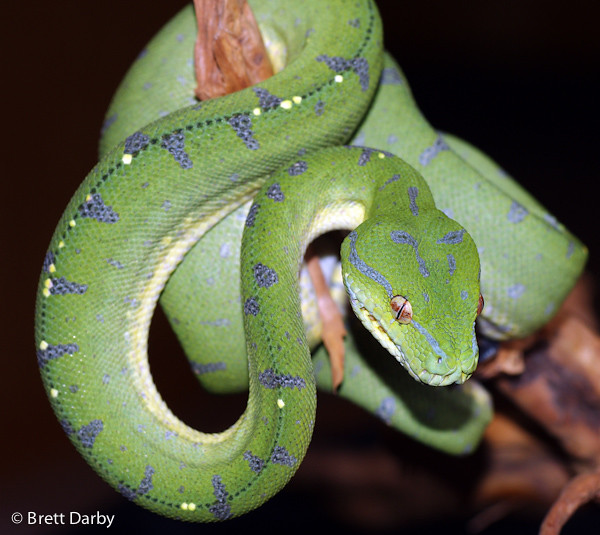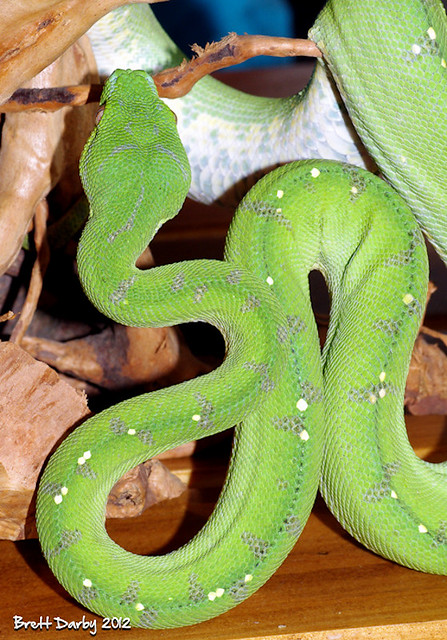You are using an out of date browser. It may not display this or other websites correctly.
You should upgrade or use an alternative browser.
You should upgrade or use an alternative browser.
Show us your greens!!!
- Thread starter lgotje
- Start date

Help Support Aussie Pythons & Snakes Forum:
This site may earn a commission from merchant affiliate
links, including eBay, Amazon, and others.
- Status
- Not open for further replies.
dickyknee
Almost Legendary
Wow Brett, that native male has turned out really well. His colours are so vibrant.
Is that one that you bought from Michael Cermak?
The bottom pic is not native though is it?
Bottom one is NOT native , I just got lazy with the file names and called them all the same thing
The natives are from Michael , very happy with them too , as usual the female is hiding her head so no good shots of her but I will get her one day...
Older pic of the male

GTP Aussies by Brett Darby, on Flickr
Older pic of the female

Green Tree Python by Brett Darby, on Flickr
Female

Aussie Female GTP_ by Brett Darby, on Flickr
dickyknee
Almost Legendary
Let me know when you get them to keep that black line Michael as I'll grab a few more 
I had no idea how sooky they are Michael , I moved the female to a new cage a few weeks back , she hid under her paper for 3 days , So I added "her" plants / perches / bowl etc from her old cage and she still would not come out from under the paper , after a few more days under the paper I decided to try moving her back to her old cage , 2 minutes later she is happily perched and has not moved since ....
I had no idea how sooky they are Michael , I moved the female to a new cage a few weeks back , she hid under her paper for 3 days , So I added "her" plants / perches / bowl etc from her old cage and she still would not come out from under the paper , after a few more days under the paper I decided to try moving her back to her old cage , 2 minutes later she is happily perched and has not moved since ....
females mate, females, that's what it is. 
That's interesting, thanks for the feedback. I shift my juvies from 2 litre containers to bigger ones when needed but I never had such experience. One solution - don't give here any place to hide. LOL
That's interesting, thanks for the feedback. I shift my juvies from 2 litre containers to bigger ones when needed but I never had such experience. One solution - don't give here any place to hide. LOL
Thanks Brett. They're stunning specimens! I notice that they both have the black vertebral pinstripe or 'shadow stripe' as I prefer to call it. Were they from the same clutch?Bottom one is NOT native , I just got lazy with the file names and called them all the same thing...
The natives are from Michael , very happy with them too , as usual the female is hiding her head so no good shots of her but I will get her one day...
Yes, they're great examples of an intriguing phenomena. I reckon that the 'shadow stripe' serves to neutralize the juvenile 'ghost stripe' for camouflage purposes. What do you think Michael?Yet another one with the black line we talked about with Dan. Strange stuff.
dickyknee
Almost Legendary
females mate, females, that's what it is.
That's interesting, thanks for the feedback. I shift my juvies from 2 litre containers to bigger ones when needed but I never had such experience. One solution - don't give here any place to hide. LOL
I line all my green cages with Butchers paper then about 50mm or so of mulch , leaf litter etc on top of that ( makes for easy cleaning ) so I was a little shocked when I found her under there ... at first I assumed I had an escapee on my hands till I noticed there was substrate in the glass track and thought to look under it just in case ...
Thanks Brett. They're stunning specimens! I notice that they both have the black vertebral pinstripe or 'shadow stripe' as I prefer to call it. Were they from the same clutch?
Yes, they're great examples of an intriguing phenomena. I reckon that the 'shadow stripe' serves to neutralize the juvenile 'ghost stripe' for camouflage purposes. What do you think Michael?
Pat, why "shadow stripe" if it's jet black?
Brett, it would be the case if it was consistent. In all the juveniles I reared up, only a handful had this "black dotting" (that's my terminology
dickyknee
Almost Legendary
Thanks Brett. They're stunning specimens! I notice that they both have the black vertebral pinstripe or 'shadow stripe' as I prefer to call it. Were they from the same clutch?
Yes, they're great examples of an intriguing phenomena. I reckon that the 'shadow stripe' serves to neutralize the juvenile 'ghost stripe' for camouflage purposes. What do you think Michael?
From memory they are from the same clutch F6M2 , the black in the stripe is all but gone now in both animals.
Hey Pat,
Your right about the stripe aiding camouflage. However, this is a general trait found in many species (e.g., viridis, C. caninus, B. gabonica) and is independent of stripe colour. It's called disruptive colouration. The idea being that because these snakes coil up during the day when visual predators are around, the pattern along the vertebrae breaks up their outline against the forest, making them harder to detect than a solid (unpatterned) green lump.
A great test of it can be found here; "Visual Predators Select for Crypticity and Polymorphism in Virtual Pre" by Alan B. Bond and Alan Kamil
Your right about the stripe aiding camouflage. However, this is a general trait found in many species (e.g., viridis, C. caninus, B. gabonica) and is independent of stripe colour. It's called disruptive colouration. The idea being that because these snakes coil up during the day when visual predators are around, the pattern along the vertebrae breaks up their outline against the forest, making them harder to detect than a solid (unpatterned) green lump.
A great test of it can be found here; "Visual Predators Select for Crypticity and Polymorphism in Virtual Pre" by Alan B. Bond and Alan Kamil
Hi Dan. Thanks very much for your thoughts on this. I suppose that the purplish-brown juvenile markings serve a similar function. Thanks for the link to that paper, which looks like a good read. 8)Hey Pat,
Your right about the stripe aiding camouflage. However, this is a general trait found in many species (e.g., viridis, C. caninus, B. gabonica) and is independent of stripe colour. It's called disruptive colouration. The idea being that because these snakes coil up during the day when visual predators are around, the pattern along the vertebrae breaks up their outline against the forest, making them harder to detect than a solid (unpatterned) green lump.
A great test of it can be found here; "Visual Predators Select for Crypticity and Polymorphism in Virtual Pre" by Alan B. Bond and Alan Kamil
In the specimens that I bred that have the dark vertebral stripe, I perceived it to be shadowy rather than jet black.Pat, why "shadow stripe" if it's jet black?
... In all the juveniles I reared up, only a handful had this "black dotting" (that's my terminology, just to be different)
Another one this morning. What really threw me, she had no pre-lay slough. The last time she sloughed was on 25th March.
I wonder if she pushed the one egg to the side because she is not big enough to cover them all. There is even a slight gap at the top where she has got her head.
Any thoughts on that?

I wonder if she pushed the one egg to the side because she is not big enough to cover them all. There is even a slight gap at the top where she has got her head.
Any thoughts on that?

This happened with one of my clutches Michael. The excluded egg turned out to be the only one that was infertile, despite looking as good as the others. I reckon that the mother can smell infertile eggs and deliberately doesn't include them, as they will soon rot and potentially spoil the good eggs.
-Katana-
Well-Known Member
- Joined
- Mar 26, 2009
- Messages
- 994
- Reaction score
- 1
Another one this morning. What really threw me, she had no pre-lay slough. The last time she sloughed was on 25th March.
I wonder if she pushed the one egg to the side because she is not big enough to cover them all. There is even a slight gap at the top where she has got her head.
Any thoughts on that?

Likes x 1000.
This happened with one of my clutches Michael. The excluded egg turned out to be the only one that was infertile, despite looking as good as the others. I reckon that the mother can smell infertile eggs and deliberately doesn't include them, as they will soon rot and potentially spoil the good eggs.
Pat I am afraid I have to disagree. From previous experiences, they don't seem to discard slugs. In this particular clutch, there was one slug and that was included in the cluster, yet a good looking egg was pushed out, or she simply didn't manage to scoop it up. Time will tell if this discarded egg is fertile or not (I didn't candle them).
Well done michael, have you ever had a female not have a pre lay shed before.
No, I haven't but from memory, Rico mentioned that it can happen sometimes. She certainly tricked me, last night she was on the perch and this morning she was sitting on eggs. Just as well I checked inside her box.
- Status
- Not open for further replies.
Similar threads
- Replies
- 69
- Views
- 24K




